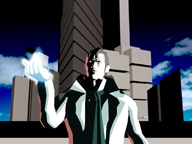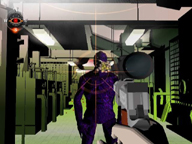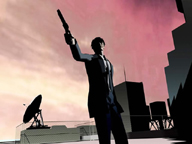Killer 7 - Making Gameplay Obsolete
Originally published 2005, October 26.
Much has been written about Killer 7, and its "lack" of traditional gameplay. The reviews that have lambasted it as shallow and uninvolved nearly all believe it's just about graphics, style, and story. What is hardly mentioned is how this really doesn't matter.
Killer 7's purpose is not to be played, it is to play you.
 |
This theory is especially supported by Killer 7's focus on post-modernism (four parallel storylines, seven separate personalities, transcendent time, and gobs of symbolism). It's the gameplay equivalent of breaking the fourth wall, something attempted previously in Eternal Darkness. The best example in Killer 7 is probably the boss of chapter 4 (the Handsome Men). First, the player is forced to automatically lose parts of the boss fight, destroying their sense of how to progress. Next, the final phase is concluded with the boss becoming amiable and simply talking. Afterward, the graphics degrade into a retro, NES-like, style - something especially strange and confusing. All this from a boss fight, which were up until that point in the game fairly difficult to figure out, if not to perform.
 |
Of course I don't think this makes the game perfect. It probably would have been possible to have this game play the player - and have enjoyable gameplay - at the same time. It would have been nice if more time had been spent on balancing out the mechanics, but the result is interesting nonetheless.
 |
However, I still unabashedly like the on-rails aspect. Every since Mario 64 got free roaming 3-d right, countless follow ups have gotten it horribly wrong. In most 3-d "games", there's more of a challenge in navigating (often benign) environments than there is in actual gameplay. Whereas in 2-d games, trivial navigation usually meant holding the right button (and periodically pushing "jump"), in 3-d it requires wrestling with an analog stick, playing with a sloppily implemented camera (Ninja Gaiden, I'm looking at you), and judging arbitrary distances between polygons (Way to go for realism, guys. I too have trouble waking down the halls in my house without running into walls). Killer 7 made it nice and simple - hold down this button to go from point A to point B. Leave the overdone control schemes for the parts of the game I should actually care about. It would be nice if more games follow this control mechanic in the future.
